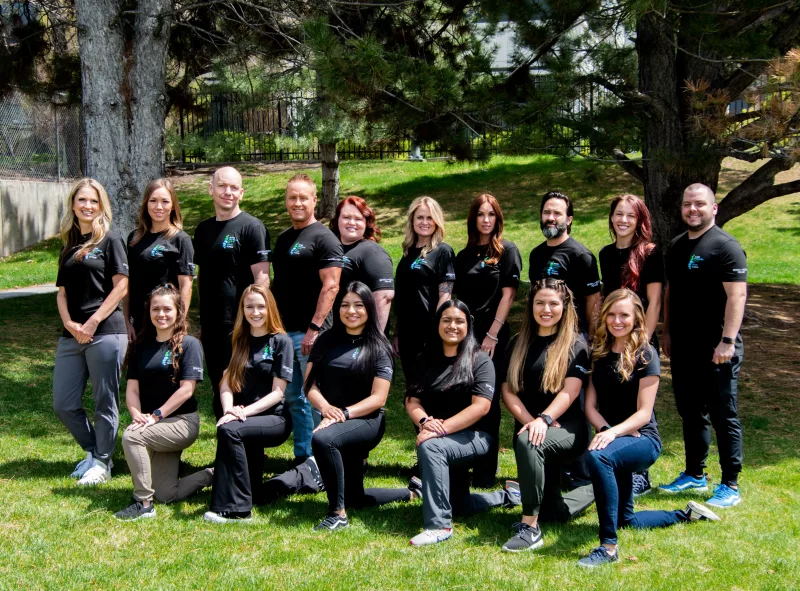Pain Management Utah
Our certified physiotherapists are experts in analyzing movement and diagnosing the source of discomfort. Our thorough assessments evaluate everything from range of motion and strength to coordination and joint mechanics, providing us with the information we need to develop effective personalized treatment plans.

Creating customized treatments for pain relief that combine a variety of physiotherapeutic techniques. From gentle manual therapy to targeted exercises, our team of professionals is dedicated to helping you get the relief you need and restoring your mobility. Schedule an appointment today and take the first step on the road to recovery!
Our approach to pain management is a three-step process:
- Phase One : is to diagnose the problem or injury and to alleviate pain and reduce inflammation as quickly as possible.
- Phase Two : is to begin corrective care, and restore biomechanics integrity with therapeutic treatments and exercises.
- Phase Three : involves stabilization to strengthen and rebuild the muscles, ligaments, tendons, and supportive connective tissues.

Common injuries from an auto accident and how physical therapy can help
Auto accidents can result in a wide range of injuries, including head and neck injuries, broken bones, internal organ damage, and spinal cord injuries. Depending on the severity of the injury, physical therapy may be recommended to patients to help facilitate recovery.
Physical therapy can help restore strength and mobility by improving joint flexibility and muscle functioning. Additionally, physical therapists and physicians can use manual techniques to reduce pain and inflammation associated with an injury.
Exercise is also an important part of physical therapy, allowing individuals to regain range of motion while strengthening impacted areas of the body. Physical therapists and providers are skilled at designing rehabilitation programs tailored to individual needs to help speed up recovery following an auto accident.
Treating and managing chronic pain
Whiplash (head and neck pain)
Whiplash is a neck injury, usually caused by a sudden head-to-head movement, such as in an auto accident. Symptoms of whiplash include pain and stiffness in the neck, shoulders, and upper back; headaches; dizziness; blurred vision; tinnitus (ringing in the ears); shoulder or arm pain; and fatigue.
Physical therapy can be an effective tool for treating whiplash. Therapists may use techniques such as ultrasound, electrical stimulation, stretching exercises, and massage to reduce pain and inflammation and improve range of motion. Strengthening exercises can also be used to improve muscle strength around the affected areas and prevent further injury.
Additionally, physical therapists are highly skilled at creating rehabilitation programs tailored to individual needs that can help individuals recovering from whiplash maximize their recovery potential.

Low Back Pain
Low back pain is one of the most common injuries that can occur in an auto accident. Symptoms of chronic pain range from dull aches to sudden, sharp pains and can be localized or radiating. Physical therapy is a great tool for managing low back pain caused by an auto accident.
Therapists may use manual techniques and treatments such as massage, mobilization, and soft tissue manipulation to reduce pain and stiffness. They may also use modalities like ultrasound or electrical stimulation to reduce inflammation around the affected area.
Exercise is an important part of physical therapy for low back pain management, allowing individuals to restore range of motion while strengthening weakened muscles around the spine.
Extremity (arms or legs)
Injuries to arms and legs, or extremities, are very common in auto accidents. Symptoms of extremity injuries can range from bruising to fractures, dislocations, or nerve damage and can be extremely painful and debilitating.
How to get start with us
Here are the simple steps… Once you have filled out our new patient questionnaire for your appointment, someone from our team will take you through a thorough history & examination which allows us to render an accurate diagnosis of your condition.
If determined to be necessary, imaging such procedures as X-rays or MRI may be ordered. We will then create a treatment plan that optimizes your recovery process.
At AIHI Clinics our treatment plans utilize evidence based protocols to ensure your best possible outcome and recovery. We are committed to your health & look forward to serving you.
Our two locations are conveniently located in Murray and Pleasant Grove! You can be assured that you will receive the best possible care close to home. Come visit us today and experience our cutting-edge treatments for physical pain management.

Utah Pain management FAQs
What is physical therapy pain management?
Physical therapy pain management is a form of treatment that uses various techniques such as massage, mobilization, stretching and exercise to reduce tension around areas of injury, improve range of motion and reduce inflammation.
What are the benefits of physical therapy for pain management?
The benefits of physical therapy for pain management include improved mobility, increased strength and flexibility, reduced pain, accelerated healing time and improved back health and quality of life.
How long do sessions typically last?
Sessions typically last from 30 minutes to an hour, depending on the individual’s schedule and needs.
Who can benefit from physical therapy for pain management?
Physical therapy is beneficial for many patients and anyone who suffers from chronic or acute musculoskeletal pain due to an auto accident, surgery or other injury.
Are there any risks associated with physical therapy?
Generally speaking, physical therapy is considered safe; however it is important to discuss any such procedures and potential risks with your doctor prior to beginning any treatment plan.
What should I expect during my first session?
Your initial session will generally include a thorough evaluation where the therapist will assess your level of function, record observations about range of motion, strength and balance tests as well as your medical records, medications and other pertinent information related to your condition.
